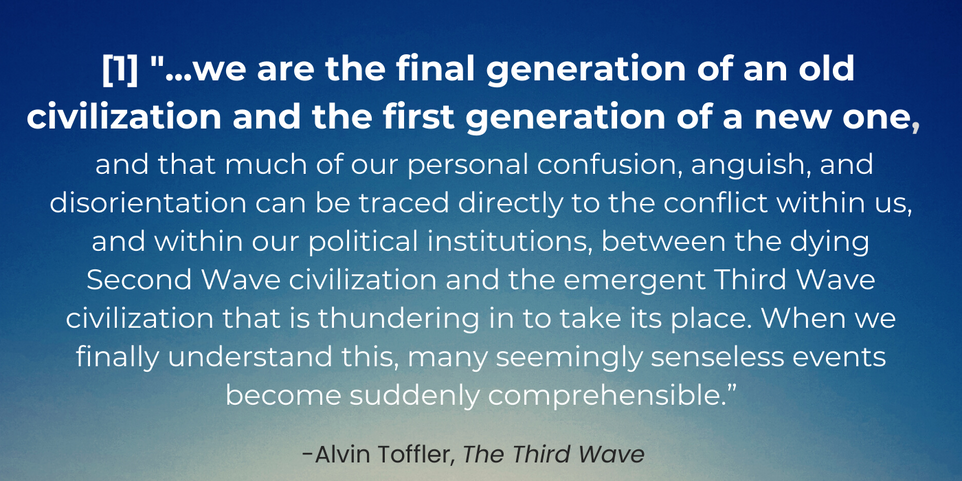Change is Painful.Strong Executive Leadership Makes All the Difference

Change amplifies past challenges
We find ourselves at a precipice of many changes. As a society, we are facing a global pandemic, we are reckoning with racial and gender inequities that have been generations in the making, and we are struggling with a polarized political environment that may be preventing us from thriving as a country.
Any one of these conversations is anxiety-inducing, yet we find ourselves having to face and address them all at once. As a futurist, I look to history and the changing nature of our society and ask: “Are our current challenges a cause or a symptom of change?”
Look to the future to navigate unequal and rapid change
When looking through the lens of our larger society, we can see that much of our current unrest is a reaction to the unequal, yet rapid, pace of changes. Our consciousness has evolved faster than we’ve been able to eliminate systemic racism from our institutions. Our technology is moving faster than our ability to absorb it into our daily lives, as we struggle with understanding the privacy implications of the simplest of applications. Despite knowing that the arc of humanity leans to the side of equity and inclusion as well as technology and discovery, we still feel the pain when the status quo is disrupted.
While we could fight the changes, it is a more fruitful exercise to understand them, recognizing the process of change and the opportunities they provide, while still acknowledging that change can produce anxiety. By understanding what these waves of change[1] will ultimately mean to us, both as a society and as individuals, we can begin to manage the change more honestly. Looking at cars now, we cannot imagine clinging to a horse and buggy, just as I cannot imagine going back to a Blackberry. With change comes progress.
Our time will be better spent looking to the future for answers instead of wishing for the past.
Strong leaders transform organizations by embracing the future
Organizations now must embrace and navigate the discord and ambiguity of change. We must use our voices to speak authentically to our stakeholders and help them understand the way forward. Understanding the change process can provide a deceivingly simple roadmap for leaders. It is our obligation to assist our stakeholders in the transition that gives them a voice and a way to create a vision for the future.
In an effort to use change to their advantage, leaders need to:
- Understand the change in the larger, longer arc of transformation.
- Design for success in that transformed, future world.
- Define those immediate-, mid-, and long-term changes and begin your transformation.
Assess how macro forces will affect your organization
Understanding the larger, longer arc of transformation is easier than it sounds. It requires an intellectual curiosity and an openness to new ideas. It requires re-evaluating existing beliefs and an inquiry into “what if.” We must learn to recognize cognitive dissonance as a tool we use to make ourselves more comfortable with our own status quo and to understand that, for the foreseeable future, change is constant, whether we like it or not. At Toffler Associates, we use a combination of open literature and expert interviews for each of our projects to stay current on the changes underway in society and to identify the drivers of future changes. You can start by understanding the larger macro forces of change impacting your organization (e.g., pandemic-driven remote work) and the innovations occurring in other industries (e.g., Amazon’s 2-day delivery).
Tailor a design for your organization’s future success
Each organization needs to design for themselves how they will be successful along this arc of change. To ignore this step is to go the way of Blockbuster and Kodak. Given the changes that are occurring in societal expectations, customer values, and disruptive technology – how will you be successful in the future? What options are there, and how fast do you need to change? What are those changes you can make now that will be successful, regardless of possible futures?
Identify changes your organization can make today to realize that future
Once you have your five- to ten-year vision for the future, define those immediate changes and capabilities that you need in your current plan. What capabilities will you require to compete in this new, digitized world? How are your customer values becoming clearer, and what stance do you need to take as stakeholders demand to know what you stand for? What do you need to do differently next year, and how will you get there?
Future Shock is all the more with us 50 years later
As we celebrate the 50th Anniversary of Alvin and Heidi’s seminal work, Future Shock, we can better appreciate the definition they gave the condition:
future shock, Pronunciation /ˈfyo͞oCHər SHäk/ /ˈfjutʃər ʃɑk/, noun
Origin: 1970s popularized by the 1970 book Future Shock by Alvin Toffler (1928–2016).
A state of distress or disorientation due to rapid social or technological change.[2]
Future shock is more evident than ever in our society and in our own lives. However, by embracing a model of preparing for the future, we have tools to navigate the uncertainty and define our success.
Toffler Associates helps leaders define and build to future success
Let us know if we can help you with your way forward. If your focus is on the future, today’s chaos takes on a different light and is simply a symptom of transformation. By understanding the opportunities the future provides, organizations can develop a strategic advantage.
Toffler Associates has spent more than 25 years helping our clients navigate future uncertainty and times of significant ambiguity. We aim to help our clients understand their best future by being clear-eyed about challenges and opportunities and by helping them define a path forward, beyond current ambiguities.
If you would like to understand what your best future may be, please contact us.
[1] The Third Wave, Alvin Toffler
[2] Oxford Dictionary
- Categories
- Futures and Foresight
- Workforce of the Future



 About the Authors
About the Authors